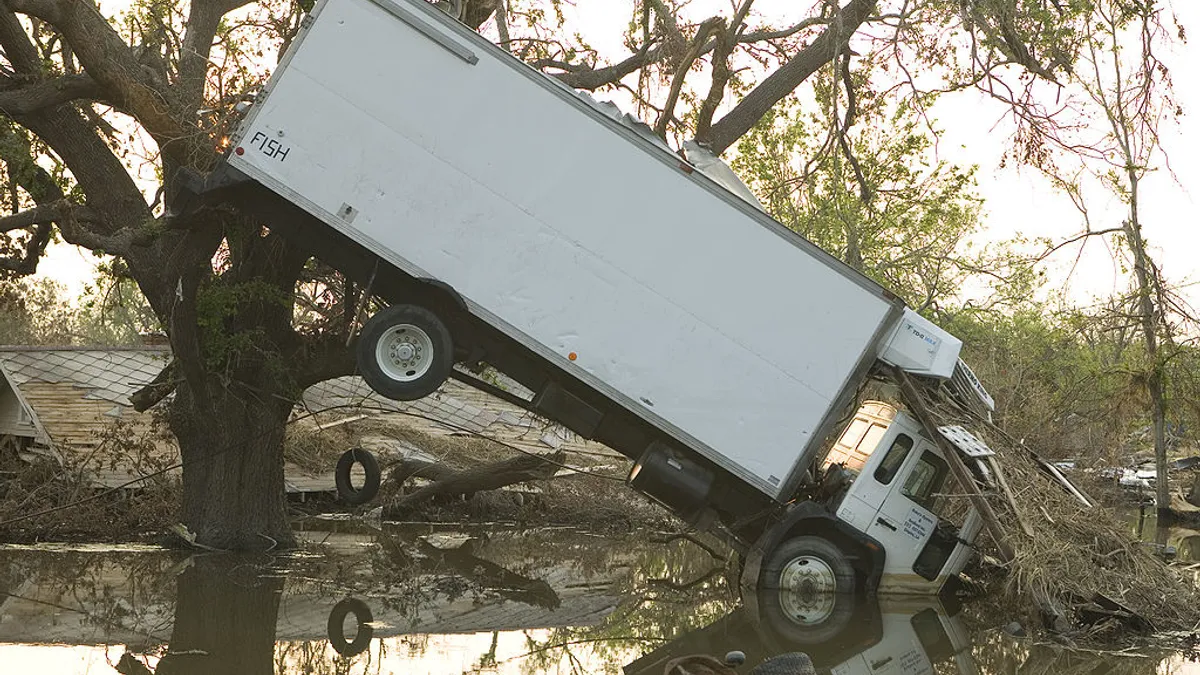Editor's Note: This story is part of a spotlight series on supply chain risk management. To see all of the stories in this series, please click here.
We can’t avoid natural disasters. But there are things we can do after it strikes to ensure that the supply chain stays intact and business keeps running. Unfortunately, too many organizations don’t know how to respond.
According to The Swiss Re Group, a Zurich, Switzerland, wholesale provider of insurance and reinsurance, 2016 was certainly no exception. Among the most expensive natural disasters last year, Japanese earthquakes cost between $20 billion and $40 billion. Canadian wildfires ($3.9 billion), storms and floods in Europe ($3.9 billion), Hurricane Matthew ($8 billion) and hailstorms throughout the United States ($3.5 billion).
And 2017 isn’t faring much better. Through July, the United States alone has endured 49 separate climate and flood disasters, according to data from Munich Re, another global reinsurance firm. Munich Re estimates the costs at $21 billion of which, it says, approximately $14.2 billion was insured.
Even with a strong risk management plan in place, Mother Nature will do what she does.
The consequences of any business disruption can be devastating and far-reaching. Data from The Business Continuity Institute (BCI-Zurich) 2016 Resiliency Report shows:
-
Loss of productivity 68% (up 10% over previous year)
-
Increased cost of working 53% (up 14%)
-
Damage to brand reputation or image 38% (up 11%)
-
Customer complaints received 40% (unchanged)
-
Service outcome impaired 40% (up 4%)
-
Loss of revenue 37% (down 1%)
There’s no quick turnaround
A major natural disaster can affect any industry. A key metric following a natural disaster (or any other supply chain disruption) is Time-to-Recover (T-t-R). The more time with no production, the lower the odds that the business will survive.
According to the Federal Emergency Management Agency (FEMA), more than 40% of businesses never reopen after a disaster, and for those that do, only 29% were still operating after two years. And, FEMA says, if IT is down for nine days or more after a disaster, bankruptcy will follow within a year.
More than 40% of businesses never reopen after a disaster, and for those that do, only 29% were still operating after two years.

Federal Emergency Management Agency
Even those who survive suffer great loss. The EventWatch 2016 Annual Report from Resilinc, a West Coast-based provider of supply chain resiliency solutions, points out that the Japanese earthquakes of April 2016 affected 214 sites, 1,824 parts and took about 36 weeks before all businesses were back. The July 7, 2016, typhoon that struck Taiwan affected 5,393 sites and 29,827 parts with an average T-t-R of 30 weeks.
Insuring against disaster
You’ve planned, you’ve mapped your supply chain so you know the strengths and weaknesses of all your suppliers, not just Tier 1, but 2, 3 and 4. You’ve even prepared and run scenarios, but are you ready for that Black Swan event, the tsunami that roars through the Pacific or the earthquake that shakes the West Coast of the U.S.?
“Companies can buy supply chain disruption insurance (SDCI),” says Greg Schlegel, founder of The Supply Chain Risk Management Consortium and a supply chain executive for more than 30 years. “They’re called business interruption (BI), continuity business insurance (CBI), trade disruption insurance (TDI) and more.”
These policies are more wide-ranging than property insurance, covering profits that would have been earned, according to trade group Adjusters International. It’s applicable to all types of businesses, as it is designed to put a business in the same financial position it would have been in had no loss occurred. It can cover net income (profit or loss before taxes) and normal operating expenses that continue after a disruption, including payroll.
Insurance can cover net income (profit or loss before taxes) and normal operating expenses that continue after a disruption, including payroll.

Adjusters International
The Dallas-based International Risk Management Institute offers a formula to help businesses calculate their claims: BI = T x Q x V. T equals the number of time units operations are shut down; Q equals the quantity of goods normally produced or sold during that unit of time; and V equals the value of each unit of production (usually expressed in profit).
The road to recovery
In the immediate aftermath of a disaster, it’s not easy to keep a clear head, so here are some tips for making a full recovery:
-
Renew business as quickly as possible: conduct inventory assessments, identify alternate suppliers and maintain sufficient insurance.
-
Have a plan in place to ensure equipment is safe and operational (or know where to find replacements or sub-contractors).
-
Determine recovery time objectives and how to meet them.
-
Determine what must be accomplished before the premises are safe for return.
It’s also vital to reach all your key stakeholders as soon as possible following the disaster, including employees, customers, suppliers and distributors. Let your customers know when you plan to reopen, when you can take orders and begin deliveries. Talk to your suppliers to find out if they suffered damage and if they still can provide your products and services. (Again, it’s important to have mapped your supply chain, run scenarios and discovered alternate suppliers).
A good mantra to keep in mind is, “It’s not what’s going to happen, it’s when.” That Black Swan can swim in at any time. Rebounding from a disaster requires planning and preparation. When the storm comes, it’s too late to start.





















